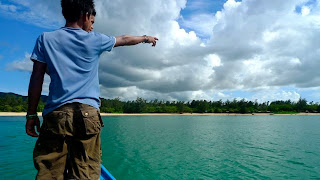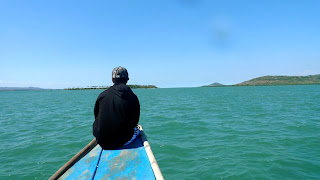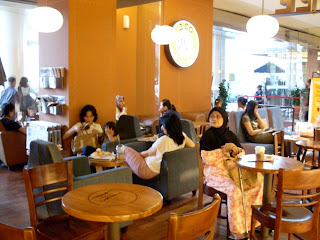Dali: Graceful Charm
It was quite a struggle deciding on moving onto Lijiang or stopping by at Dali for a night. The German I talked to lived in Dali for 5 months, teaching English, and she couldn't stop sharing good things about Dali. So, with that, I decided to extend my stay in China, and catch a 4-hour bus ride to Dali in the morning.
I arrived in Dali at 1PM, and the weather was fair. It was sunny but it grew colder than Kunming. I took a taxi to my guesthouse, the Jade Emu near the West Gate of Dali Old Town. It wasn't inside the old town, compared to all the other guesthouses, but the place was easily accessible as it was near the highway already. The guesthouse was spotless and the beds were comfortable. China really has great hostels.

I only had a night, so I immediately unloaded my stuff and asked the receptionist the way to the Cangshan Mountains. I have read that one could take a chair lift to a village on top. So that's what I did. I took a sort of tuktuk to the mountain park entrance and got on a chair lift (80RMB two way). The park rangers told me I had to be back at 6PM, so practically I had 2 hours to explore.

It took 25 minutes to go up, and it was a long 20 minutes, but was very relaxing. The wind blew on my chair lift, which made the ride pretty scary at some points. On the way up of course, I was treated to a dazzling view of Dali, Erhai Lake and the surrounding mountains.

I arrived at the top and there was no one around. Well, that's a good thing. No Chinese tours. It was relaxing to be in a place in China where there was no one around. I explored the village, which had a temple.

There really wasn't much to do around, until I saw a sign that led to attractions. The sign pointed to a waterfall, caves, and other scenic spots in the mountain. Of course, they were all far away (2 kms), so I figured I couldn't visit them. I headed to the waterfalls on a paved path. Around 1 km into the trail, a European guy told me that the trail was blocked and that I had to turn back. Hmmm....so I did, without seeing anything but the constant views of Dali and Erhai Lake, amidst a pine tree forest.

I went back to the village and saw an old Bai woman in blue cooking by what seemed to be her house. I asked where I could get some food, and she gladly offered me some from her kitchen. She offered me a kind of root, like raddish, which I ate. It tasted like raddish but it wasn't. After that brief encounter, I went back to the chair lift and descended from the mountain.

On the way down, I noticed tombstones on the slopes of the mountain. I remember the German girl telling me about these tombstones, because she visited a burial site of one of her foster families. The sun was setting and I was literally the last person on the mountain. After I got off the chair lift, the Chinese rangers closed the lift and bolted the gates.

I walked down the entrance, and found no taxi or tuktuk. So I decided to walk back further down into the highway. I passed local villages, with water wheels on their canals. It was not an old village, but more modern. Think a cluster of newly built Chinese homes in a suburb. At last, I made it to the highway just in front of the South Gate of Dali Old Town.

I entered the walled town, and was immediately transported to a different world. So this is what an old town looks like, much like West St in Yangshuo, but more antique and authentic. I took out my map and guided myself to Foreigner St. as I was very hungry. I settled down in a restaurant and ate traditional Bai food.

After dinner, I wandered around my first Chinese old town. I witnessed more towering gates and streams along cobble stone streets. I heard that Dali Old Town has been transformed to look more like a tourist destination, which is sad I think. The Chinese love to improve the look of their scenic spots, but they sometimes overdo it. I passed by a movie showing of an old Chinese movie shot in Dali. An old film projector was used to beam the movie on a wide screen on a wall of a gate.

After going around small Dali Old Town, I decided to go back to the guesthouse. I struggled to find a way out of the walled town a bit, but I made it. I planned what I would do the next morning, and it seemed like the scenic area of the Congsheng Temple was the best choice.

The next morning, I woke up refreshed from all the walking the day before. I got some breakfast and headed straight to the Congsheng Temple and 3 Pagoda Scenic Spots. A huge red gate greeted me, and I paid entrance again to get in. Instead of taking the normal route, which is from the 3 Pagodas going up to the Buddha Academy, I took a shuttle bus to the top near the Buddha Academy. From there, I went down.

The Buddhist Academy was a tranquil place. There was Chinese music being played, which soothed my senses. I took some pictures of the facade, but didn't go in anymore. I knew I had 2 hours only, before I leave for Lijiang. I went down to the next temple and saw a lot of offerings to the god it houses.

I stood on a vantage point and saw around 6 more temples on the way down. The stairs connecting the temples were wide. I really felt like I was in a Chinese movie, where the hero goes up to the temples one by one until he reaches the top.

The Congsheng Temple Complex had a history, as it was destroyed by a recent earthquake. I hopped temple after temple, each of which had a different god. See the one below.

Finally, I was near where I began, the site of the 3 Pagodas. The 3 Pagodas has become the landmark of Dali as it is already more than 8,000 years old. It withstood the earthquake, but repairs have been made. The best views of the 3 pagodas are from a pond at the back of the 3 pagodas (when you are going up) or near the exit of the park, where a minimalist garden blooms.

All in all, Dali can be summed up into one word: charming. It is a graceful city, as everyone looks laid back. I wasn't able to visit the Erhai Lake, and explore the Cangshans, but I thought that my stay in Dali was enough. One more night would be perfect. But I booked a bus ticket to Lijiang at 12 NOON, moving closer to my ultimate destination, Shangrila.
I arrived in Dali at 1PM, and the weather was fair. It was sunny but it grew colder than Kunming. I took a taxi to my guesthouse, the Jade Emu near the West Gate of Dali Old Town. It wasn't inside the old town, compared to all the other guesthouses, but the place was easily accessible as it was near the highway already. The guesthouse was spotless and the beds were comfortable. China really has great hostels.

I only had a night, so I immediately unloaded my stuff and asked the receptionist the way to the Cangshan Mountains. I have read that one could take a chair lift to a village on top. So that's what I did. I took a sort of tuktuk to the mountain park entrance and got on a chair lift (80RMB two way). The park rangers told me I had to be back at 6PM, so practically I had 2 hours to explore.

It took 25 minutes to go up, and it was a long 20 minutes, but was very relaxing. The wind blew on my chair lift, which made the ride pretty scary at some points. On the way up of course, I was treated to a dazzling view of Dali, Erhai Lake and the surrounding mountains.

I arrived at the top and there was no one around. Well, that's a good thing. No Chinese tours. It was relaxing to be in a place in China where there was no one around. I explored the village, which had a temple.

There really wasn't much to do around, until I saw a sign that led to attractions. The sign pointed to a waterfall, caves, and other scenic spots in the mountain. Of course, they were all far away (2 kms), so I figured I couldn't visit them. I headed to the waterfalls on a paved path. Around 1 km into the trail, a European guy told me that the trail was blocked and that I had to turn back. Hmmm....so I did, without seeing anything but the constant views of Dali and Erhai Lake, amidst a pine tree forest.

I went back to the village and saw an old Bai woman in blue cooking by what seemed to be her house. I asked where I could get some food, and she gladly offered me some from her kitchen. She offered me a kind of root, like raddish, which I ate. It tasted like raddish but it wasn't. After that brief encounter, I went back to the chair lift and descended from the mountain.

On the way down, I noticed tombstones on the slopes of the mountain. I remember the German girl telling me about these tombstones, because she visited a burial site of one of her foster families. The sun was setting and I was literally the last person on the mountain. After I got off the chair lift, the Chinese rangers closed the lift and bolted the gates.

I walked down the entrance, and found no taxi or tuktuk. So I decided to walk back further down into the highway. I passed local villages, with water wheels on their canals. It was not an old village, but more modern. Think a cluster of newly built Chinese homes in a suburb. At last, I made it to the highway just in front of the South Gate of Dali Old Town.

I entered the walled town, and was immediately transported to a different world. So this is what an old town looks like, much like West St in Yangshuo, but more antique and authentic. I took out my map and guided myself to Foreigner St. as I was very hungry. I settled down in a restaurant and ate traditional Bai food.

After dinner, I wandered around my first Chinese old town. I witnessed more towering gates and streams along cobble stone streets. I heard that Dali Old Town has been transformed to look more like a tourist destination, which is sad I think. The Chinese love to improve the look of their scenic spots, but they sometimes overdo it. I passed by a movie showing of an old Chinese movie shot in Dali. An old film projector was used to beam the movie on a wide screen on a wall of a gate.

After going around small Dali Old Town, I decided to go back to the guesthouse. I struggled to find a way out of the walled town a bit, but I made it. I planned what I would do the next morning, and it seemed like the scenic area of the Congsheng Temple was the best choice.

The next morning, I woke up refreshed from all the walking the day before. I got some breakfast and headed straight to the Congsheng Temple and 3 Pagoda Scenic Spots. A huge red gate greeted me, and I paid entrance again to get in. Instead of taking the normal route, which is from the 3 Pagodas going up to the Buddha Academy, I took a shuttle bus to the top near the Buddha Academy. From there, I went down.

The Buddhist Academy was a tranquil place. There was Chinese music being played, which soothed my senses. I took some pictures of the facade, but didn't go in anymore. I knew I had 2 hours only, before I leave for Lijiang. I went down to the next temple and saw a lot of offerings to the god it houses.

I stood on a vantage point and saw around 6 more temples on the way down. The stairs connecting the temples were wide. I really felt like I was in a Chinese movie, where the hero goes up to the temples one by one until he reaches the top.

The Congsheng Temple Complex had a history, as it was destroyed by a recent earthquake. I hopped temple after temple, each of which had a different god. See the one below.

Finally, I was near where I began, the site of the 3 Pagodas. The 3 Pagodas has become the landmark of Dali as it is already more than 8,000 years old. It withstood the earthquake, but repairs have been made. The best views of the 3 pagodas are from a pond at the back of the 3 pagodas (when you are going up) or near the exit of the park, where a minimalist garden blooms.

All in all, Dali can be summed up into one word: charming. It is a graceful city, as everyone looks laid back. I wasn't able to visit the Erhai Lake, and explore the Cangshans, but I thought that my stay in Dali was enough. One more night would be perfect. But I booked a bus ticket to Lijiang at 12 NOON, moving closer to my ultimate destination, Shangrila.



Comments
Post a Comment